![]()
![]()
![]()
Use LEFT and RIGHT arrow keys to navigate between flashcards;
Use UP and DOWN arrow keys to flip the card;
H to show hint;
A reads text to speech;
67 Cards in this Set
- Front
- Back
|
The Days of the Gold Standard: What System & Why?
|
Bretton Woods System
- US dollar as "world" currency - All others pegged to the dollar - Dollar was convertible to gold at $35/oz Why? - The US economy accounted for 70% of global GDP in 1944 - Highest productivity - Greatest trade surplus |
|
|
Collapse of the Gold Standard: When & Why?
|
Bretton Woods ended 1973
- Gold standard abandoned: US dollar floats - How to redeem all those dollars at $35/oz? Vietnam; Petro-dollars; Inflation Weakening export position: Deteriorating current account |
|
|
Policy Options: Free Float, Dirty Float, Fixed Float
|
Exchange Rate Regimes
Free Float: Leave it to supply and demand - Can be subject to high volatility Dirty Float: Allow flat within a certain bandwidth - How dirty depends on the bandwidth Fixed: Set at a rate specified by the government - Pegged: Linked to a single strong currency |
|
|
Foreign Exchange: What is it?
|
It is a commodity that consists of currencies issued by countries other than one's own.
- One of the key issues that differentiate international business from domestic business. - A strong dollar buys more foreign currency, and a weak dollar buys less foreign currency |
|
|
Exchange Rates: Definition Expanded & Why Does it Matter?
|
The price of currency in terms of my own currency
Why does it matter to me or my company? - Determines how much I have to pay for my imports so it effects the terms of trade. |
|
|
What would you want in your primary currency?
|
Stable
Convertible Commonly Traded |
|
|
Hard Currencies/Soft Currencies
|
Hard Currencies
- Currencies that are freely tradable, or convertible - Tend to maintain value - Example: Euro, US Dollar, Canadian Dollar, Japanese Yen Soft Currencies - Currencies that are not freely tradable because of domestic laws or the unwillingness of foreigners to hold them - Often lose value - Example: Ruble, Dong, Cuban Peso |
|
|
What currencies were commonly traded in 2001?
|
Deutsche Mark, French Franc, Other EU
|
|
|
Exchange Rates Expanded: Function & Demand
|
Supply & Demand
- Exchange rate is a price function: A function of supply and demand - As demand for a given currency goes up (at a given supply), so does the price of the currency in terms of the other currency (i.e., the exchange rate) - As demand goes down (at a given supply), the price of that currency will drop in terms of the other currency |
|
|
Exchange Rates: Money Supply
|
Money Supply
- The aggregate value of the money supply should reflect the change of the national economy - Changes in the money supply will put pressure on exchange rates |
|
|
Exchange Rates: Trade
|
Current Account Balance Affects x-rates
- Trade Surplus: More money coming into country than leaving it, this pushes money up. - Trade Deficit: More money leaving the country, this pushes money down. US used to have a current account surplus: It exported more than it imported, which propped up the dollar's value. |
|
|
A Strengthening Dollar Helps?
A Weakening Dollar Helps? |
Appreciating currency is both good and bad
A strengthening dollar helps: - Importers and consumers of imported goods - US firms with offshore outsourcing - Foreign debt holders A weakening dollar helps: - Domestic, import-competing industries - Exporters - MNEs repatriating income from abroad |
|
|
Managing Exchange Rates: Currency Hedging & Strategic Hedging?
|
Spot Transactions
- See what you get when the account is due Currency Hedging: Through forward contracts - Hinges on predictions of x-rate fluctuations Strategic Hedging: Through geographic spread - By spreading sales/production over many currency areas it all "balances out in the end" Also: Shifting x-rate risk onto your trading partner |
|
|
Deal-Focused vs. Relationship-Focused H/L Context
|
Low Context
- More open to outsiders - Direct initial contact - Deal first for first meeting - Less frequent face-to-face contact High Context - Less open to outsiders - Indirect initial contact - Relationship first for first meeting - More frequent face-to-face contact |
|
|
Deal-Focused vs. Relationship-Focused Cultures
|
Deal-Focused Business Cultures
- North America, Australia/New Zealand, Northern Europe, Britain Moderately Deal-Focused - France, Belgium, Southern Europe, Russia, East-Central Europe, Hong Kong, Singapore Relationship-Focused Business Cultures - Most of Asia, Arab World, Mediterranean Region, Latin America, Most of Africa |
|
|
Informal vs. Formal H/L Context
|
Low Context
- Smaller status differences (hierarchical) - More familiar forms of address - Simpler protocol rituals High Context - Larger status differences (hierarchical) - More formal forms of address - More elaborate protocol rituals |
|
|
Informal vs. Formal Cultures
|
Less Formal Business Cultures
- Australia, Norway, Denmark, Iceland, USA, Canada, New Zealand More Formal Business Cultures - Most of Europe, Mediterranean Region, Latin America, Africa, Asia |
|
|
The Language of Time: Cultural Differences in Time - Definition
|
Monochronic People: One thing at a time, concentrate on the job, take time commitment seriously, etc.
Polychronic People: Do many things at once, are highly distractible and subject to interruptions, consider time commitments an objective to be achieved, if possible, etc. |
|
|
Monochronic Time vs. Polychronic Time: H/L Context
|
Low Context
- Very important punctuality - Rigid schedules and deadline - Seldom meetings, interrupted High Context - Less important punctuality - Flexible schedules, deadlines - Frequently meetings, interrupted |
|
|
Monochronic Time vs. Polychronic Time: Cultures
|
Monochronic Business Cultures
- Germany, German-Switzerland (very monochronic), North America, Northern Europe, Japan Moderately Monochronic - Southern Europe, Russia, East-Central Europe, China, Singapore, hong Kong, Taiwan, South Korea Polychronic Business Cultures - Most of Southeast Asia, South Asia, Latin America, Arab World, Most of Africa |
|
|
Expressive vs. Reserved Communication*
|
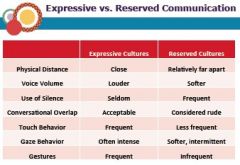
Physical Distance
Voice Volume Use of Silence Conversational Overlap Track Behavior Gaze Behavior Gestures |
|
|
Expressive Cultures - Example
Variably Expressive - Example Reserved Cultures - Example |
Expressive Cultures
- Spain, Portugal, Southern Europe, Mediterranean, West Africa, Latin America Variably Expressive - USA, Canada, Australia, Russia, East-Central Europe, South Asia Reserved Cultures - Northern Europe, Britain, East and Southeast Asia |
|
|
Relationship to Other Cultural Constructs Quote (Gudykunst and Ting-Toomey)
|
"High and low context schema is isomorphic with Hofstede's individualist and collectivist cultures" - Gudykunst and Ting-Toomey, 1988
|
|
|
Hofstede's Dimensions
|
Power Distance
- Weaker members acceptance of inequality Individualism - Loose ties between individuals; each responsible for him/herself Masculinity - The degree to which men have different values than women Uncertainty Avoidance - A function of how comfortable group members feel with uncertainty Long-term Orientation - Thrift & Perseverance |
|
|
High vs. Low Power Distance*
|
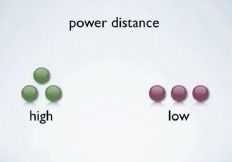
|
|
|
Power Distance: H/L Context
|
Power Distance is Higher When
- A good working relationship with your direct superior is important Power Distance is Lower When - You are okay with an organizational structure in which certain subordinates have two bosses |
|
|
High/Low Power Distance*
|
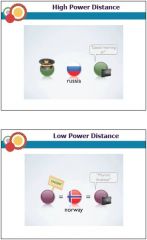
|
|
|
Individualism H/L Context
|
Individualism is Greater When
- Sufficient time for your personal or family life is important Individualism in Lower When - Variety and adventure in the job is important |
|
|
Masculinity H/L Context
|
Masculinity is Greater When:
- There is a distribution of roles between the sexes assertive, competitive, decisive Masculinity is Lower When: - There is a sense of modesty and caring for others relationships, compromise and negotiate |
|
|
Uncertainty H/L Context
|
Uncertainty avoidance is higher when:
you feel nervous or tense at work and have an emotional need for rules Uncertainty avoidance is lower when: you have a dislike of rules and want a less formalized and standardized work environment |
|
|
Long-Term Orientation: H/L Context
|
Long-term orientation is greater when:
- You attach more importance to thrift / being economical Short -term orientation is when: - You attach respect for tradition and ‘saving face’ |
|
|
Individualism vs. Collectivism*
|
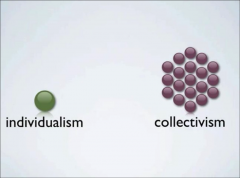
|
|
|
Individualism*
|
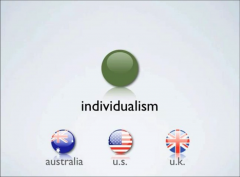
|
|
|
Collectivism*
|
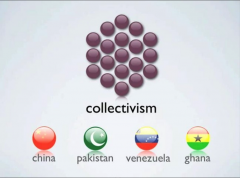
|
|
|
Culture: Quote, Liability of Foreignness, Org. Culture
|
"The collective programming of the mind which distinguishes the members of one group or category of people from another" - Geert Hofstede
Cultural misunderstandings part of the "liability of foreignness" Organizational culture is a distinct concept, but is to some extent a function of culture |
|
|
Determinants of Culture: Graph*
|
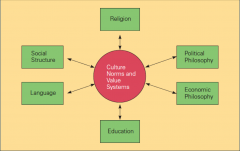
How does religion impact culture?
Don't read on the differences of Hindu, Confucius, etc. |
|
|
Culture: H/L Context
|
High/ Low Context
- The degree to which individuals within a culture rely on contextual cues to convey and interpret meaning - High/low context helps us to understand how cultural values are manifested in communication and interaction patterns Low-Context Cultures - Culture in which communication is usually taken at face value - Emphasis on VERBAL cues that should NOT be subject to multiple interpretations High-Context Cultures - Culture in which communication relies a lot on the underlying unspoken context - Emphasis on NON-VERBAL cues and an understanding of the context |
|
|
Edward Hall: The Hidden Dimension - Four Key Contextual Cues
|
Four Key Contextual Cues
1. Direct/Indirect Messages & Explicit/Implicit Meanings 2. The Language of Relationships - Deal focused vs. Relationship oriented - Formal vs. Informal 3. The Language of Time - Monochronic vs. Polychronic 4. The Language of Space - Expressive vs. Reserved Communication |
|
|
Direct/Explicit Communication Cultures
Indirect/Implicit Meaning Cultures |
Direct / Explicit Language Cultures
- Germany, German-Switzerland (very direct) - N. America, Australia/New Zealand, N. Europe, Britain, Flemish Belgium Less Direct / Explicit Cultures - France, Belgium, Southern Europe, Russia, East-Central Europe, Hong Kong, Singapore Indirect / Implicit Language Cultures - Most of Asia, Arab world, Mediterranean region, Latin America, most of Africa |
|
|
Deal-Focused vs. Relationship-Focused Cultures
|
Deal-Focused Business Cultures
- North America, Australia/New Zealand, Northern Europe, Britain Moderately Deal-Focused - France, Belgium, Southern Europe, Russia, East-Central Europe, Hong Kong, Singapore Relationship-Focused Business Cultures - Most of Asia, Arab world, Mediterranean region, Latin America, most of Africa |
|
|
Informal vs. Formal Cultures
|
Less Formal Business Cultures
- Australia, Norway, Denmark, Iceland, USA, Canada, New Zealand More Formal Business Cultures - Most of Europe, Mediterranean region, Latin America, Africa, Asia |
|
|
Monochronic Time vs. Polychronic Time Cultures
|
Monochronic Business Cultures
- Germany, German-Switzerland (very monochronic) North America, Northern Europe, Japan Moderately Monochronic - Southern Europe, Russia, East-Central Europe, China, Singapore, Hong Kong, Taiwan, South Korea Polychronic Business Cultures - Most of Southeast Asia, South Asia, Latin America, Arab world, most of Africa |
|
|
Expressive vs. Reserved Communication Cultures
|
Expressive Cultures
- Spain, Portugal, Southern Europe, Mediterranean, West Africa, Latin America Variably Expressive - USA, Canada, Australia, Russia, East-Central Europe, South Asia Reserved Cultures - Northern Europe, Britain, East and Southeast Asia |
|
|
Relationship to Other Cultural Constructs
|
“High and low context schema is isomorphic with Hofstede’s individualist and collectivist cultures” - Gudykunst and Ting-Toomey, 1988
|
|
|
Expressive vs. Reserved Communication*
|
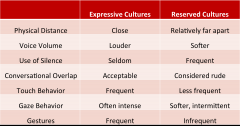
|
|
|
Monochronic Time vs. Polychronic Time*
|

|
|
|
Informal vs. Formal*
|

|
|
|
Deal-Focused vs. Relationship-Focused*
|
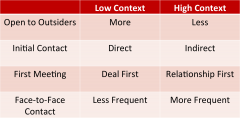
|
|
|
The Function of Institutions
|
Institutions mean RULES, both formal (regulatory environment) and informal (norms & culture).
Institutions provide incentive structures for behavior (rewards for compliance as well as sanctions for violations) Institutions thus reduce uncertainty and opportunism, keeping transaction costs low |
|
|
Liability of Foreignness
|
When you enter a new environment—either as a manager or as an MNE (Multinational Enterprise)—you face the disadvantage that comes from not knowing THE RULES.
This disadvantage means higher transaction costs & greater risk of experiencing opportunistic behavior |
|
|
Pillars of Institution
|
Regulative (Formal)
Normative (Informal) Cognitive (Informal) |
|
|
Normative
|
Normative is related to peer pressure / social expectations
- “You should wash your hands after using the restroom” - “You should take off your shoes when entering a home” - “You should pass the ball when playing basketball” |
|
|
Cognitive
|
Cognitive is related to deep-seated assumptions and often hard to explain
- “Winning is the most important thing” - “Government intervention is bad” - “Polygamy is wrong” |
|
|
Institutions can be weak or strong!
|
“Institutional weakness” means incentive structures are absent, arbitrary, or at least non-transparent
This translates into unpredictability and thus risk: political risk, legal risk, financial risk Depends on whether society is rule-based or relationship-based: - In rule-based settings, institutions are more transparent and predictable (to outsiders) than in relationship-based settings |
|
|
Institutional Differences: Risk
|
Corruption and bribery
- ‘Facilitating payments’ are not uncommon - US has laws against bribery abroad (i.e., the Foreign Corrupt Practices Act) - But: how to define bribery, especially where a technical, legal definition is lacking? |
|
|
Risk Due to Different Systems: Civil, Common, Theocratic Law
|
Civil Law
- Based on Roman Law and Napoleonic Code Judgment based on application of statutes Common Law - Based on precedents and traditions Judgment based on interpretation of law Theocratic Law - Based on religious teachings |
|
|
Sources of Political Risks
|
Embargoes and sanctions (e.g. Cuba, North Korea)
Boycotts (e.g. Shell / Nigeria) Terrorism (e.g. Spain (ETA), Iraq, Indonesia, Pakistan, Afghanistan) Hostage taking (e.g. Colombia) Expropriation (seizure of assets by government) |
|
|
Business-Government Dynamics: Firms have TWO basic strategies to exert pressure on politicians!
|
Firms have two basic strategies to exert pressure on politicians: Voice and Exit
- Voice typically means lobbying, but can also be collective bargaining - Exit means relocating value-adding activities offshore (or at least the threat) |
|
|
Voice: Money Spent
|
Voice’ is big business. In the US in 2012, for instance:
- US Chamber of Commerce spent $66.3.1 million - GE spent $26.3 million - AT&T spent $20.2 million - Drug and Health Care spent $2.4 billion: $19 million per day Congress was in session, or $1.6million per hour |
|
|
Exit vs. Voice
|
Threat of relocation is real, but should not be overstated governments want their firms to stay
So does the firm! |
|
|
Gross Domestic Product (GDP)
Gross National Income (GNI) |
Total market value of all final goods and services produced within a country in a given period of time usually a calendar year.
The term used by the World Bank and other international organizations to supersede the GNP term. Like GNP, it means GDP plus net income from nonresident, domestically owned assets |
|
|
Forces of Localization: The CAGE Distance Framework (Ghemawat)
|
Distance does matter!
Cultural Distance - Different languages, ethnicities, religions, values and norms Administrative Distance - Differences in corruption, legal rules, political risk and instability, government policies and colonal ties Geographic Distance - Physical remoteness, lack of a common border, lack of sea or river access, size of country, weak transportation or communication links, climates Economic Distance - Differences in consumer incomes, costs and human and natural resource |
|
|
Glocalization
|
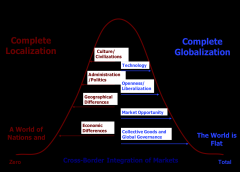
Tension between globalization and localization.
Glocalization: This tension is the fundamental source of uncertainty in international business, as the world is neither completely globalized nor completely localized. |
|
|
Tension between Globalization and Localization: Firm Strategy
Global Integration of Value Chain Adaptation of Product/Marketing Organizational Centralization/Decentralization Market Entry Decision Integrated Non-Market Strategy |
Tension between globalization and localization.
Global Integration of Value Chain - Should we globally connect our value chain or should we separate it by region/nation? Adaptation of Product/Marketing - Should we develop and sell a standardized or should we develop and sell a product adapted to local conditions? Organizational Centralization/Decentralization - Should we centralize control in global headquarters or decentralize it to local subsidiaries? Market Entry Decision - How should we exploit global opportunities - either by gaining global competitive advantages or gaining new market share - given large national differences in culture and institutions? When should we enter, or avoid, a particular country? Integrated Non-Market Strategy - Should we follow and adopt global standards of appropriate behavior or should we allow local variation in what is considered acceptable organizational behavior? |
|
|
Forces of Globalization
|
Globalization refers to the broadening and deepening of interactions and interdependences among peoples and countries of the world.
Broadening: The extension of economic and geographic linkages to encompass virtually all major societies and states. Deepening: An increase in the frequency and intensity of state and societal interactions. |
|
|
Forces of Localization
|
Localization refers to the segmentation and contraction of the interactions and interdependences among peoples and countries of the world
- Nationalism - Cultural Diversity and Values - History and Tradition - Security Concerns |
|
|
Business Government Dynamics Differ Across Countries: PCC
|
‘Pluralist’ Countries
- Large number of interests exist w/ equal access to policymakers; government relatively neutral ‘Corporatist’ Countries - Close ties between government and corporate elite aimed at long-term growth; greater govt intervention ‘Command’ Countries - Policies devised by government with few interests heard or represented |

